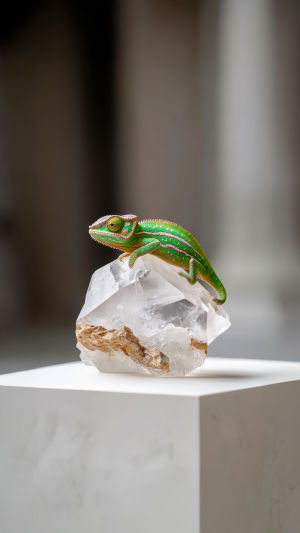Have you ever stared at a chameleon and wondered, "Is it changing color just to blend in?" Many of us believe these little reptiles are nature's masters of camouflage—but what if that's not the full story?
Let's explore together the fascinating truth behind why chameleons really change colors. You might be surprised at what we find!
<h3>More Than Just Camouflage</h3>
We usually think chameleons change color to hide from predators or sneak up on prey. While this is partly true, camouflage is only one reason. Scientists have discovered that color change also helps chameleons communicate with each other and regulate their body temperature.
This means when we see a chameleon turning bright or dark, it might not be trying to hide—it could be showing its mood, attracting a mate, or simply warming up.
<h3>The Science Behind the Change</h3>
So how exactly do chameleons change color? The answer lies in their skin. Just under the outer layer, chameleons have special cells called iridophores. These cells contain tiny crystals that reflect light. When a chameleon is calm, the crystals are packed tightly, reflecting short wavelengths like blue. When it's excited or stressed, the crystals spread apart and reflect longer wavelengths like yellow and red.
By adjusting the spacing of these crystals, chameleons can shift through a range of colors—almost like natural LED screens!
<h3>Color Signals Between Chameleons</h3>
Communication is one of the biggest reasons for color change. Male chameleons, for example, often turn bright colors when trying to impress females or warn other males to stay away. If another male gets too close, a color "showdown" might begin, where both flash vibrant colors to prove their strength.
On the other hand, a female chameleon might turn dark or show specific patterns when she doesn't want attention. It's their way of saying "not interested" without making a sound.
<h3>Using Color to Manage Temperature</h3>
Like many reptiles, chameleons can't control their body heat the way mammals do. Instead, they rely on the environment. When they're cold, they turn darker to absorb more heat from the sun. When they're hot, they shift to lighter colors to reflect sunlight and cool down.
It's a clever way to stay comfortable without moving much—and it works quickly!
<h3>Do All Chameleons Change Color?</h3>
Not all chameleons are created equal. Some species can shift through a rainbow of colors, while others have a more limited range. For example, the panther chameleon from Madagascar is known for its bold reds, blues, and yellows. In contrast, the more common veiled chameleon usually sticks to greens and browns.
But even the "less colorful" ones still use color for communication and temperature control—so the change is still meaningful.
<h3>Chameleons and Their Emotions</h3>
Believe it or not, chameleon colors can even reflect how they feel. A chameleon may darken when stressed, brighten when happy or stimulated, and fade when tired or sick. Observing these changes closely helps keepers and researchers understand their mood and health.
While they don't smile or frown like humans do, chameleons "speak" with colors in a very expressive way.
<h3>What Can We Learn from Chameleons?</h3>
We may not have color-changing skin, but chameleons teach us a lot about adapting to the world. Their ability to communicate silently, react to their environment, and remain alert without panic shows us the value of flexibility.
In our daily lives, being able to "read the room" or adjust our attitude like chameleons adjust their color is a useful skill!
<h3>Color Myths vs. Facts</h3>
Let's clear up some common myths:
• Myth: Chameleons match any background.
Fact: Their color range is limited and more about mood than perfect blending.
• Myth: Color change is instant camouflage.
Fact: The primary function is often social or thermal.
• Myth: All chameleons are colorful.
Fact: Some have more subtle changes based on species.
Understanding these facts helps us better appreciate their complexity and avoid treating them like color-changing toys.
<h3>Should We Keep Chameleons as Pets?</h3>
While chameleons are beautiful and fascinating, they need specific care: proper temperature, humidity, and space. Because they're sensitive to stress and environmental changes, they're best suited for experienced reptile keepers. If you're ever considering a chameleon, do plenty of research and make sure you can meet its needs.
If you already have one, watching its color shifts can offer clues about its health, comfort, and feelings. Pretty cool, right?
Next time you see a chameleon shift from green to bright yellow, ask yourself: "Is it feeling hot? Showing off? Or just having a moment?" Chameleons are more than nature's mood rings—they're communicators, adapters, and silent storytellers.
Do you know someone who thought chameleons only change color to hide? Share this with them—we bet they'll be surprised!





